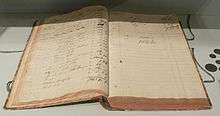Bank reconciliation
| Accounting |
|---|
 |
|
Major types |
|
Selected accounts |
|
People and organizations
|
|
Development |
|
|
A Bank reconciliation is a process that explains the difference between the bank balance shown in an organization's bank statement, as supplied by the bank, and the corresponding amount shown in the organization's own [accounting] records at a particular point of time.[1]
Such differences may occur, for example, because a cheque or a list of cheques issued by the organisation has not been presented to the bank, a banking transaction, such as a credit received, or a charge made by the bank, has not yet been recorded in the organization's books, or either the bank or the organisation itself has made an error.
It may be easy to reconcile the difference by looking at very recent transactions in either the bank statement or the organisation's own accounting records (cash book) and seeing if some combination of them tallies with the difference to be explained. Otherwise it may be necessary to go through and match every transaction in both sets of records since the last reconciliation, and see what transactions remain unmatched. The necessary adjustments should then be made in the cash book, or any timing differences recorded to assist with future reconciliations.
For this reason, and to minimise the amount of work involved, it is good practice to carry out such reconciliations at reasonably frequent intervals. Reconciliations are generally performed by specialised accounting software though the understanding of what occurs is important for a successful reconciliation. Also, Bank reconciliation statement is a statement prepared on a particular day to reconcile the bank balance as per Cash book or Bank statement showing entries causing difference between the two balances.
Abbreviations
The following abbreviations are typical abbreviations on a bank statement:
- DO - Debit order
- SO - Standing order
- IS - Insurance
- SF - Service fees
- CO- Credit order
References
- ↑ Carl S. Warren (18 January 2010). Survey of Accounting. Cengage Learning. p. 183. ISBN 978-0-538-74909-1. Retrieved 9 April 2012.
POWERED BY Abbas Laghari